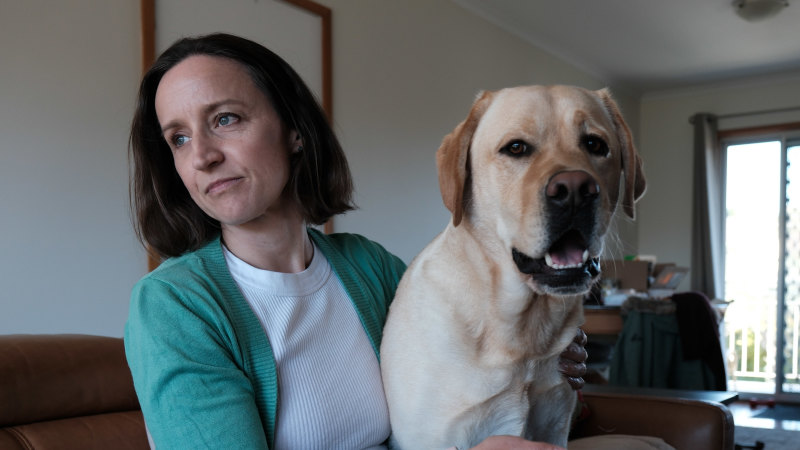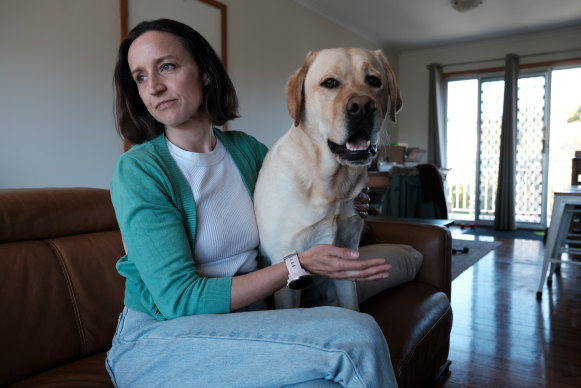Save articles for later
Add articles to your saved list and come back to them any time.
When Vicky Heaton is asked how she’ll feel if her mother cannot get a permanent parent visa to join her in Australia, her voice suddenly wavers.
Her mother, Jane, is 77, and Vicky knows that, even if she trusts the Home Affairs department’s current estimate of a 12-year wait time for a parent visa, there is slim hope that they’ll ever live in the same country again. Vicky says she and her two children are now counting the number of times they might see her again.
Vicky Heaton is one of many thousands of people waiting for their parents receive a parent visa. Credit: Oscar Colman
The recent Parkinson review into Australia’s migration system referred to waiting times for a parent visa of 40 years or more and said, bluntly: “Providing an opportunity for people to apply for a visa that will probably never come seems both cruel and unnecessary.”
“Even so,” says Vicky, “I think being in a queue is better than not having an option at all. I feel there is at least a glimmer of hope … that things might change, governments might change.”
Vicky is one of almost 140,000 Australian residents waiting between about 12 and 40 years to be reunited with their parents. The “quick” way to get such a visa – joining the contributory stream – costs $47,955 per parent and comes with a 12-year wait and growing. The official wait for the non-contributory stream is 29 years, but some estimates put it much longer.
A new report into this system by the Scanlon Foundation Research Institute says the situation is untenable. Under Australia’s strict cap on permanent migration, migrants who have the legitimate desire to have their parents join them in Australia are competing with other streams – skilled and humanitarian – and losing out.
“As successive Australian governments have shifted the emphasis of the migration program towards skill, parents have been excluded from the definition of ‘immediate family’,” says report author Peter Mares.
In recent years, as few as 3500 people have been allowed in each year on the contributory scheme and 1400 on the non-contributory scheme. The Albanese government increased the contributory intake to 7000 last year.
Mares agrees it’s a conundrum for policymakers. Australian migrants value having their parents on hand to help with children, and also want to care for their parents as they age. But in fiscal terms, research shows they cost $600,000 over their lifetime in healthcare and other costs.
Mares says the financial modelling does not take into account the harder-to-measure aspects of allowing migrants to bring their parents to Australia: having three generations in one place, maintaining cultural links and language, and providing childcare to working families.
It’s a vexed political issue, too. Politicians do not want to limit parent visas because they are highly valued among migrants living and voting in marginal seats, but likewise, they do not want to open up the scheme to clear the backlog because “big Australia” rhetoric is unpopular, particularly during a housing crisis.
Rajwant Singh says, however, that doing nothing is not an option. His mother is an applicant for a parent visa and in the queue herself, and he is also Sydney-based migration agent who works mainly with family and parent visas.
The issue, he says, is “blowing up”.
People might not leave Australia over the issue, Singh says, but new migrants might reassess their desire to come here.
He believes COVID has been a factor in the recent strong feelings on the subject because so many people could not see their parents, or care for them. Heaton agreed. During COVID, she says, “we realised that the ability to always see people you want to see might not be there forever”.
Among comparable countries, Australia’s parent visa system is “by far the most expensive, requires sponsors to meet a high level of household income and has far longer wait times and backlogs”, Mares wrote.
Canada has a much bigger program, with people selected by a lottery, and a two-to-three year wait. The United States has an uncapped parent migration system. On the other hand, the UK allows no parent migration. New Zealand, like Australia, caps the number of places but is moving to a lottery system.
Mares says a lottery system, as suggested by the Parkinson review, could work, but Australia would need to clear its backlog of applications first. “This is what Canada did,” he says.
Vicky Heaton knows it’s difficult to argue that her mother should displace a migrant from a different stream, but says it’s important that older people are not invisible. A rich diversity of people is part of what makes Australia attractive.
“And if you’re wanting people to settle and make a family … we need to support people here to bring their parents and close family with them,” she says.
The Morning Edition newsletter is our guide to the day’s most important and interesting stories, analysis and insights. Sign up here.
Most Viewed in National
From our partners
Source: Read Full Article


